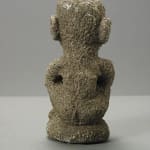Kissi Soapstone Nomoli Sculpture of a Seated Man, 16th Century CE - 20th Century CE
Soapstone
6
PF.6154
Further images
The Kissi people revere stone anthropomorphic carvings found in fields and rivers in an area located around the Sewa and Mano Rivers. They are called Pombo, meaning “the deceased.” These...
The Kissi people revere stone anthropomorphic carvings found in fields and rivers in an area located around the Sewa and Mano Rivers. They are called Pombo, meaning “the deceased.” These carvings are extremely old and it was not until 1959 that Western scholars associated them with the so-called Afro-Portuguese ivory objects carved by artists of the Sapi kingdom. Although the Sapi kingdom collapsed in the 16th century, their art survived buried beneath the ground. Occasionally, these ancient works would be accidentally unearthed, usually through flooding or farming. Kissi artists would often rework the Sapi sculptures, resulting in a multitude of variations of types and styles. This charming sculpture depicts a seated figure holding his hands just below his chin, apparently stroking his beard. Such similar beards are often the markings of the ruling elite, suggesting that this work may depict a chief. The disproportionate emphasis placed on the head of this figure is typically African and his facial features, including his large lips, flaring nose, and bulging eyes, are characteristic the type. Pombo sculptures were believed to house ancient spirits. According to Kissi belief, these sculptures acted as intermediaries between the living and their deceased ancestors. They would be worshiped on small altars or in deep bowls. The holes carved into the stomach and head of this figure suggest that magical substances were placed inside in order to activate the spiritual powers of the work. This sculpture, a literal relic of the past, continues to communicate with the lost world left behind. Magically unearthed, it is a gift from the past to the present. Surely, this sculpture was as revered by the Kissi villagers who discovered it as by the Sapi artists who crafted it.









